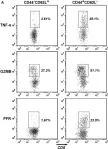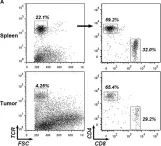Gut microbes play a crucial role in regulating the tumor microenvironment (TME) of colorectal cancer (CRC). Nevertheless, the deep mechanism between the microbiota-TME interaction has not been well explored. In this study, we for the first time discovered that Lactobacillus intestinalis (L. intestinalis) effectively suppressed tumor growth both in the AOM/DSS-induced CRC model and the ApcMin/+ spontaneous adenoma model. Our investigation revealed that L. intestinalis increased the infiltration of immune cells, particularly dendritic cells (DC), in the TME. Mechanically, the tumor-derived CCL5 induced by L. intestinalis recruited DC chemotaxis through the NOD1/NF-κB signaling pathway. In clinical samples and datasets, we found positive correlation between L. intestinalis, CCL5 level, and the DC-related genes. Our study provided a new strategy for microbial intervention for CRC and deepened the understanding of the interaction between tumor cells and the immune microenvironment modulated by gut microbes.
Product Citations: 21
In Gut Microbes on 1 December 2025 by Sun, Y., Wang, Q., et al.
-
FC/FACS
-
Mus musculus (House mouse)
-
Cancer Research
-
Immunology and Microbiology
In IScience on 16 May 2025 by Chenuet, P., Mellier, M., et al.
Detecting cytoplasmic or extracellular DNA from host or pathogen origin by DNA sensor cyclic GMP-AMP synthase (cGAS) and stimulator of interferon genes (STING) triggers immune responses with secretion of type I interferons and inflammatory cytokines. However, STING agonists function as type-2 adjuvant promoting allergic asthma. Here, we asked how cGAS/STING signaling pathway influences allergen-induced type-2 immune responses in models of allergic airway diseases induced by birch pollen extract, house dust mite, or ovalbumin plus Alum. We report increased extracellular dsDNA in the airways, together with cGAS and STING gene expression, following allergen challenge in these models, correlating dsDNA and type-2 cytokine IL-4, IL-5, and IL-13 release. Allergen-induced type-2 immune responses were reduced in cGAS- or STING-deficient mice. Further, blocking cGAS function with the specific inhibitor RU.521 protected mice from birch pollen allergen-induced airway inflammation and type-2 immune responses. Thus, DNA sensing by cGAS contributes to type-2 immune responses and may represent a therapeutic target for allergic lung inflammation.
© 2025 The Author(s).
-
Genetics
-
Immunology and Microbiology
Fasting-mimicking diet remodels gut microbiota and suppresses colorectal cancer progression.
In NPJ Biofilms and Microbiomes on 25 June 2024 by Luo, M., Wang, Q., et al.
The progression of colorectal cancer is closely associated with diet. Fasting-mimicking diet (FMD) is a promising type of dietary intervention that have beneficial effects in the prevention and treatment of various cancers. We investigated the therapeutic effect of 4-day FMD against colorectal cancer in mice through immune cell analysis, microbiota composition analysis and anti-PD-1 treatment. These FMD cycles effectively suppressed colorectal cancer growth, reduced cell proliferation and angiogenesis, increased tumor-infiltration lymphocytes especially CD8+T cells. FMD stimulated protective gut microbiota, especially Lactobacillus. Supplementation of Lactobacillus johnsonii induced similar results as FMD intervention, which also suppressed tumor growth and increased CD45+ and CD8+ T cells. Additionally, FMD synthesizing with anti-PD-1 therapy effectively inhibited CRC progression. These findings suggest that Lactobacillus. johnsonii is necessary for the anticancer process of FMD in CRC. FMD through its effects on both gut microbiota and immune system, effectively suppressed colorectal cancer progression in mouse model.
© 2024. The Author(s).
-
FC/FACS
-
Mus musculus (House mouse)
-
Cancer Research
In Haematologica on 1 March 2024 by Waraky, A., Ostlund, A., et al.
Certain subtypes of acute myeloid leukemia (AML) in children have inferior outcome, such as AML with translocation t(7;12)(q36;p13) leading to an MNX1::ETV6 fusion along with high expression of MNX1. We have identified the transforming event in this AML and possible ways of treatment. Retroviral expression of MNX1 was able to induce AML in mice, with similar gene expression and pathway enrichment to t(7;12) AML patient data. Importantly, this leukemia was only induced in immune incompetent mice using fetal but not adult hematopoietic stem and progenitor cells. The restriction in transforming capacity to cells from fetal liver is in alignment with t(7;12)(q36;p13) AML being mostly seen in infants. Expression of MNX1 led to increased histone 3 lysine 4 mono-, di- and trimethylation, reduction in H3K27me3, accompanied with changes in genome-wide chromatin accessibility and genome expression, likely mediated through MNX1 interaction with the methionine cycle and methyltransferases. MNX1 expression increased DNA damage, depletion of the Lin-/Sca1+/c-Kit+ population and skewing toward the myeloid lineage. These effects, together with leukemia development, were prevented by pre-treatment with the S-adenosylmethionine analog Sinefungin. In conclusion, we have shown the importance of MNX1 in development of AML with t(7;12), supporting a rationale for targeting MNX1 and downstream pathways.
-
Mus musculus (House mouse)
-
Cancer Research
-
Cardiovascular biology
-
Genetics
Cell state dependent effects of Bmal1 on melanoma immunity and tumorigenicity.
In Nature Communications on 20 January 2024 by Zhang, X., Pant, S. M., et al.
The circadian clock regulator Bmal1 modulates tumorigenesis, but its reported effects are inconsistent. Here, we show that Bmal1 has a context-dependent role in mouse melanoma tumor growth. Loss of Bmal1 in YUMM2.1 or B16-F10 melanoma cells eliminates clock function and diminishes hypoxic gene expression and tumorigenesis, which could be rescued by ectopic expression of HIF1α in YUMM2.1 cells. By contrast, over-expressed wild-type or a transcriptionally inactive mutant Bmal1 non-canonically sequester myosin heavy chain 9 (Myh9) to increase MRTF-SRF activity and AP-1 transcriptional signature, and shift YUMM2.1 cells from a Sox10high to a Sox9high immune resistant, mesenchymal cell state that is found in human melanomas. Our work describes a link between Bmal1, Myh9, mouse melanoma cell plasticity, and tumor immunity. This connection may underlie cancer therapeutic resistance and underpin the link between the circadian clock, MRTF-SRF and the cytoskeleton.
© 2024. The Author(s).
-
Mus musculus (House mouse)
-
Cancer Research
-
Immunology and Microbiology
In Front Immunol on 7 April 2017 by Dai, K., Huang, L., et al.
Fig.2.A

-
FC/FACS
-
Mus musculus (House mouse)
Collected and cropped from Front Immunol by CiteAb, provided under a CC-BY license
Image 1 of 2
In Front Immunol on 7 April 2017 by Dai, K., Huang, L., et al.
Fig.1.A

-
FC/FACS
-
Mus musculus (House mouse)
Collected and cropped from Front Immunol by CiteAb, provided under a CC-BY license
Image 1 of 2

